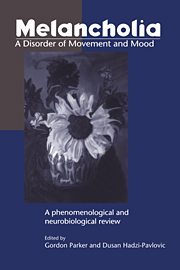Book contents
- Frontmatter
- Contents
- List of contributors
- Acknowledgments
- Introduction
- Part One Classification and Research: Historical and Theoretical Aspects
- 1 Issues in Classification: I. Some Historical Aspects
- 2 Issues in Classification: II. Classifying Melancholia
- 3 Issues in Classification: III. Utilising Behavioural Constructs in Melancholia Research
- 4 Issues in Classification: IV. Some Statistical Aspects
- Part Two Development and Validation of a Measure of Psychomotor Retardation as a Marker of Melancholia
- Part Three The Neurobiology of Melancholia
- The CORE Measure: Procedural Recommendations and Rating Guidelines
- References
- Author Index
- Subject Index
4 - Issues in Classification: IV. Some Statistical Aspects
from Part One - Classification and Research: Historical and Theoretical Aspects
Published online by Cambridge University Press: 04 August 2010
- Frontmatter
- Contents
- List of contributors
- Acknowledgments
- Introduction
- Part One Classification and Research: Historical and Theoretical Aspects
- 1 Issues in Classification: I. Some Historical Aspects
- 2 Issues in Classification: II. Classifying Melancholia
- 3 Issues in Classification: III. Utilising Behavioural Constructs in Melancholia Research
- 4 Issues in Classification: IV. Some Statistical Aspects
- Part Two Development and Validation of a Measure of Psychomotor Retardation as a Marker of Melancholia
- Part Three The Neurobiology of Melancholia
- The CORE Measure: Procedural Recommendations and Rating Guidelines
- References
- Author Index
- Subject Index
Summary
In the 1960s the unitary/binary debate about the classification of depression was complemented by a debate about the capacity of statistical methodologies to help in deciding nosological questions.
A common nosological pursuit is to examine whether a disorder is categorical or dimensional. In the broad domain of biology the task of deciding mathematically between categories and dimensions goes back to the geneticists of the late nineteenth century and Pearson's (1894) introduction of the method of moments for deriving a solution for what we now call the finite mixture model. Two persisting central concerns have been the capacities of statistical techniques to distinguish between these possibilities, and how the data we collect can mislead interpretation.
While the generic arguments were most vigorous initially in the context of depression, they touch all psychiatric disorders, and are currently perhaps most active in the area of personality research (e.g., Gangestad and Snyder 1985; Grove and Andreasen 1989; Meehl 1992).
The Nosological Question in Depression. This can be construed as a set of arguments about
whether depression lies on a continuum with normality or is a separate entity;
if depression is not on a continuum, whether the class of depressives is a continuum or comprises a number of discrete disorders; and
if depression is a discrete entity, whether the distinguishable disorders are best described using categorical or continuous description.
As noted by Eysenck (1970) “[T]here are two, not one, problems involved, relating (a) to the unitary or binary nature of depression, and (b) to the categorical or dimensional nature of these illnesses.”
Information
- Type
- Chapter
- Information
- Melancholia: A Disorder of Movement and MoodA Phenomenological and Neurobiological Review, pp. 57 - 64Publisher: Cambridge University PressPrint publication year: 1996
